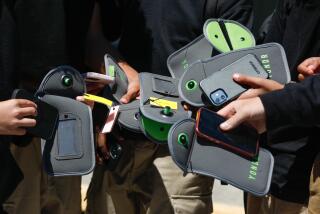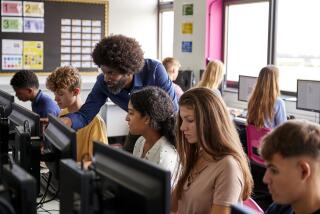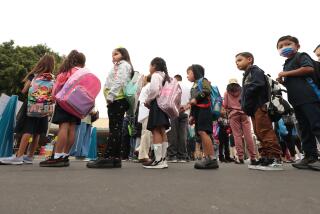One in 5 California students lack computers and Wi-Fi. Can the digital divide be closed?

- Share via
California Gov. Gavin Newsom on Monday announced that efforts are underway to get more students online amid coronavirus school closures, while acknowledging that the digital divide has hurt the distance learning of an estimated 1 in 5 low-income students.
About 70,000 computers — and internet hot spots — will go to schools and students starting this week, Newsom said as private donors, foundations, and communications and tech companies have come forward with donations.
“We continue to need to do much, much more,” Newsom said. “We’re not done. This is the beginning of a process.”
For the briefing on schools, Newsom brought forward First Partner Jennifer Siebel Newsom, who talked about research suggesting that 1 in 5 students lacked connectivity when campuses across the state began to shut down.
She also noted recent surveys indicating that 50% of low-income families and 42% of families of color are worried about distance learning for their children because they don’t have a device at home.
“The fear these parents have that their children will fall behind without internet access and devices is very real,” said Siebel Newsom. She added, “We have your back and will continue to fight for you.”
Also speaking at the governor’s daily coronavirus briefing was state Supt. of Public Instruction Tony Thurmond, who has convened a task force to address the digital divide.
“Our digital divide has gone on longer than this pandemic,” Thurmond said. “It is something that has gone on for decades.”
The current situation presents an imperative to close that gap “once and for all,” he said.
One issue with the state’s response has been the time lag in getting resources to isolated students as the end to the traditional academic year approaches.
Even school systems that didn’t wait for state help have confronted challenges. L.A. Unified immediately began distance learning, providing hot spots and computers. After two weeks, 15,000 high school students, about 12.5%, had not logged on, percentages that have improved.
On Monday, the number had dropped to 3,000. But L.A. schools Supt. Austin Beutner said it is an additional challenge to provide a strong distance-learning program and to assess student engagement, which is about more than simply logging on.
Even when it comes to logging on, there are concerns. About 7% of high school students are still not connecting electronically with their teachers every week.
L.A. Unified authorized spending $100 million for computers and hot spots, but had to purchase higher priced devices because adequate less-expensive devices were not available. Hot spots were not immediately available to families either, despite the district’s commitment to pay for them.
Sacramento Unified is experimenting with turning school buses into mobile Wi-Fi hot spots, hoping literally to roll out the initiative by May 1, about seven weeks after campuses began to close.
To bolster the state effort, a number of donors have come forward with computers and broadband service, including Google, Microsoft, Lenovo, HP, Sprint, T-Mobile, Zoom, Apple, along with individuals including internet entrepreneur Jack Dorsey and foundations including the Chan Zuckerberg Initiative.
More to Read
Sign up for Essential California
The most important California stories and recommendations in your inbox every morning.
You may occasionally receive promotional content from the Los Angeles Times.












